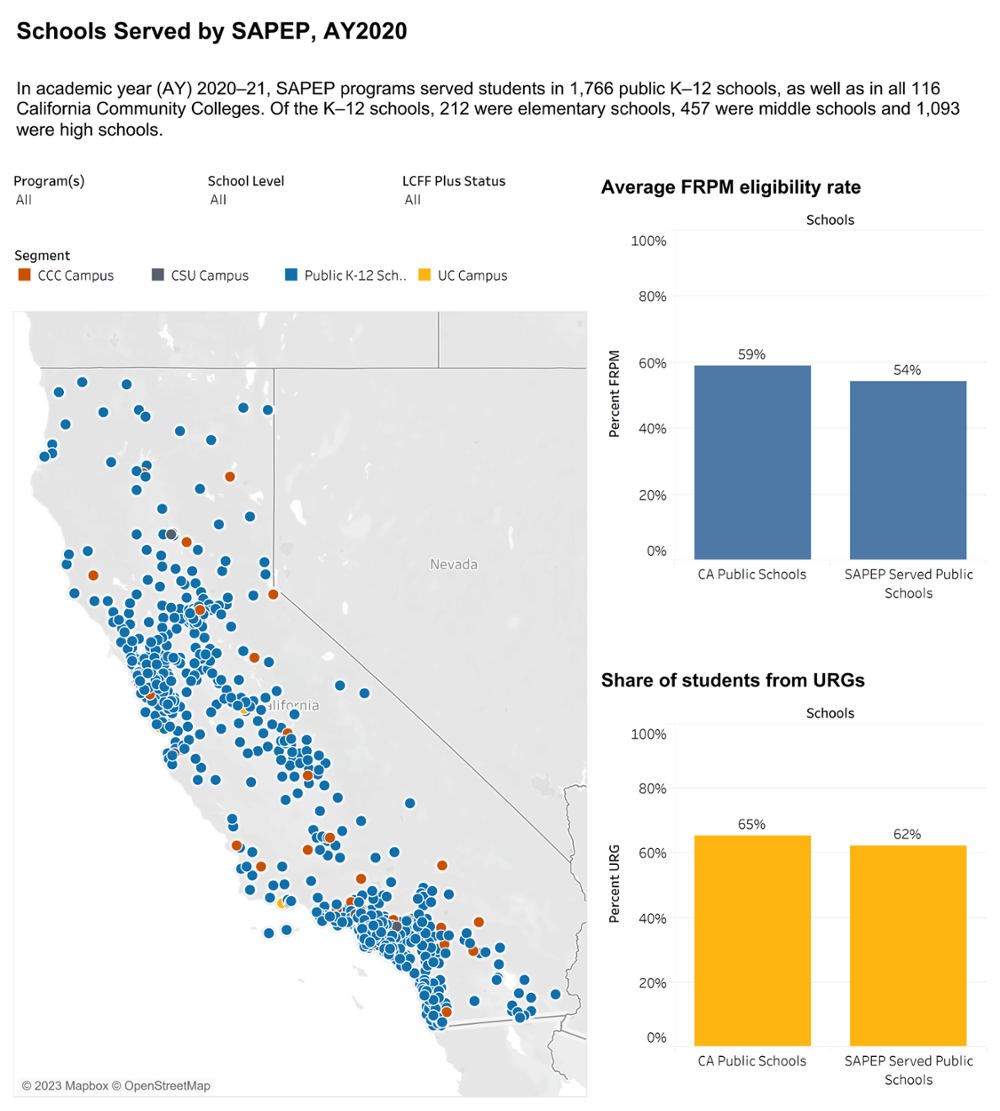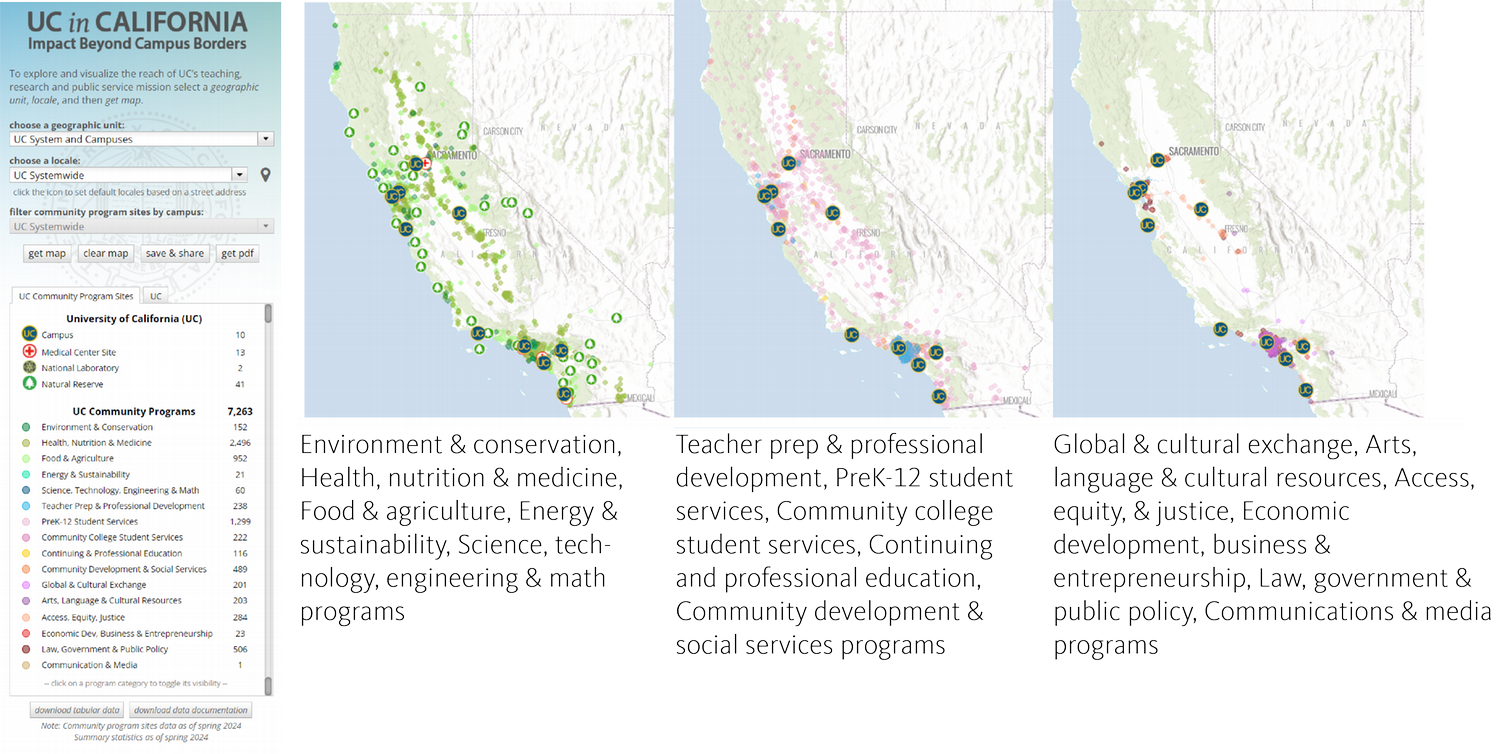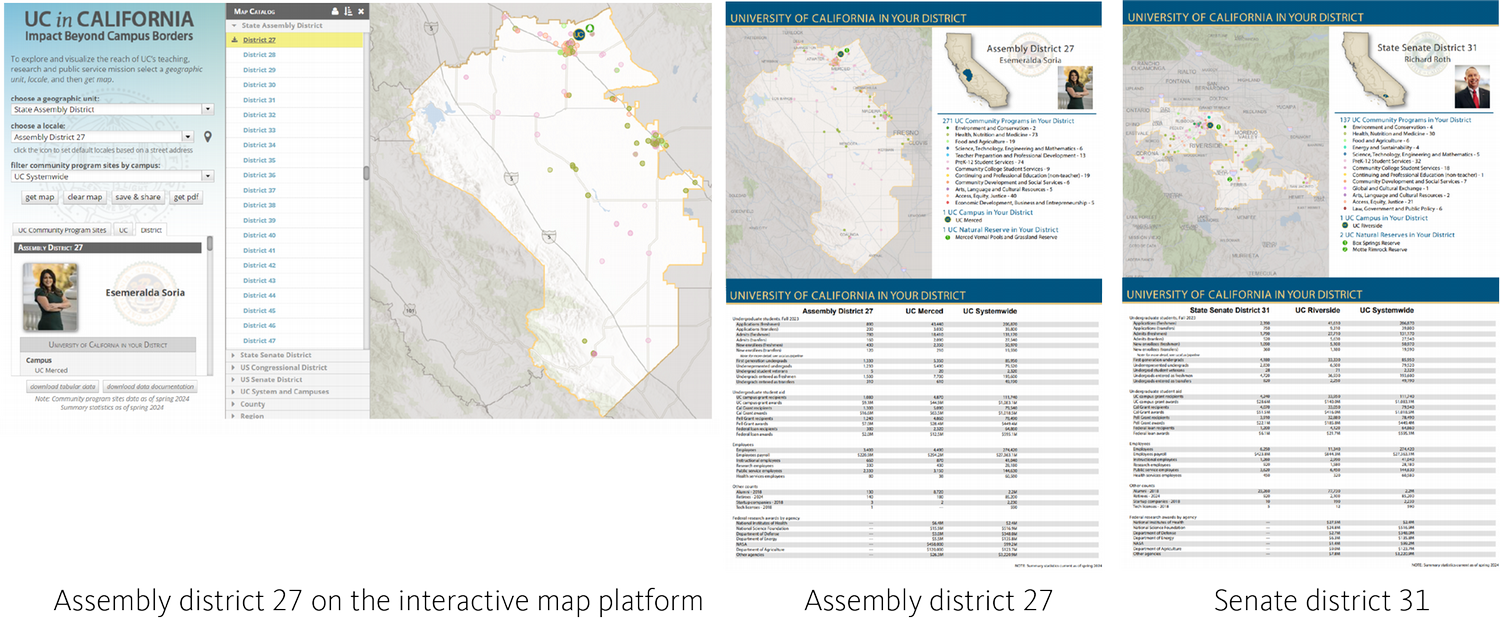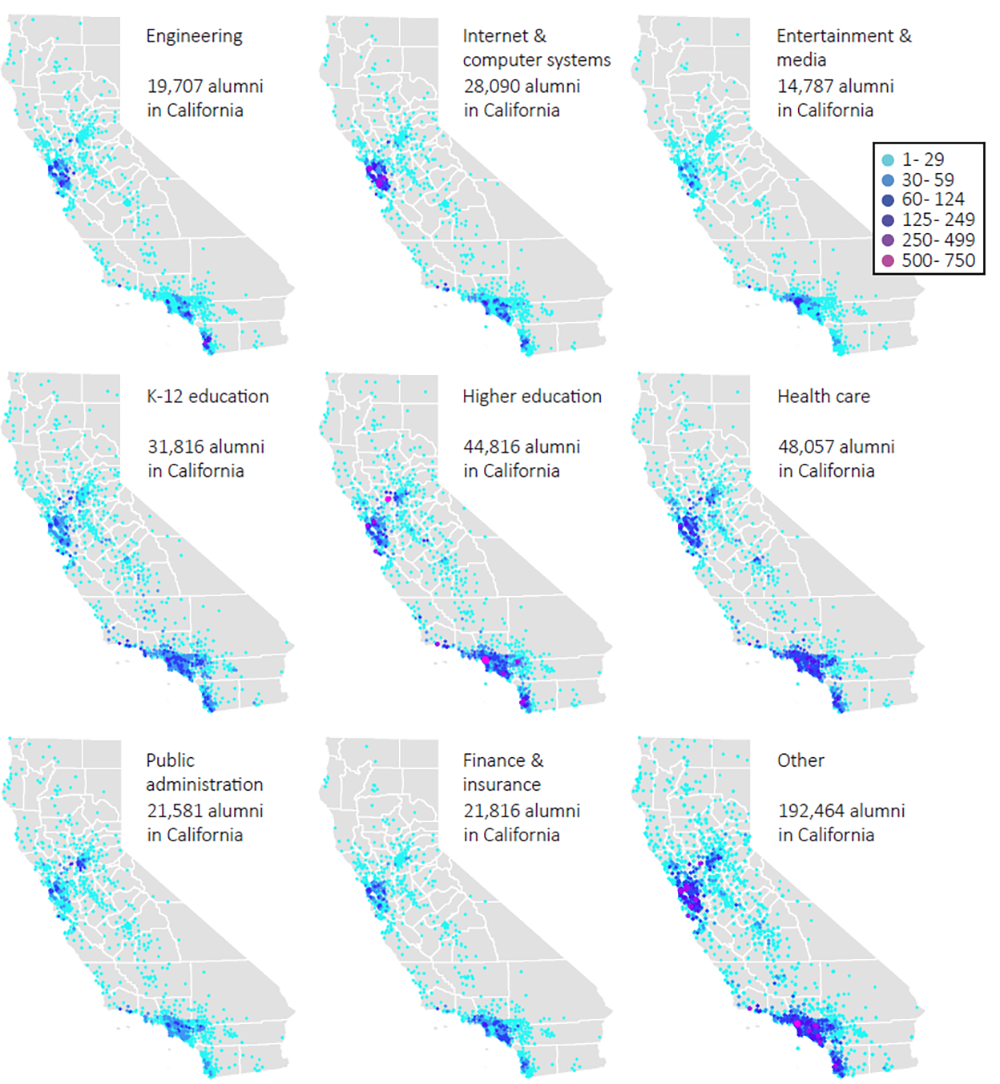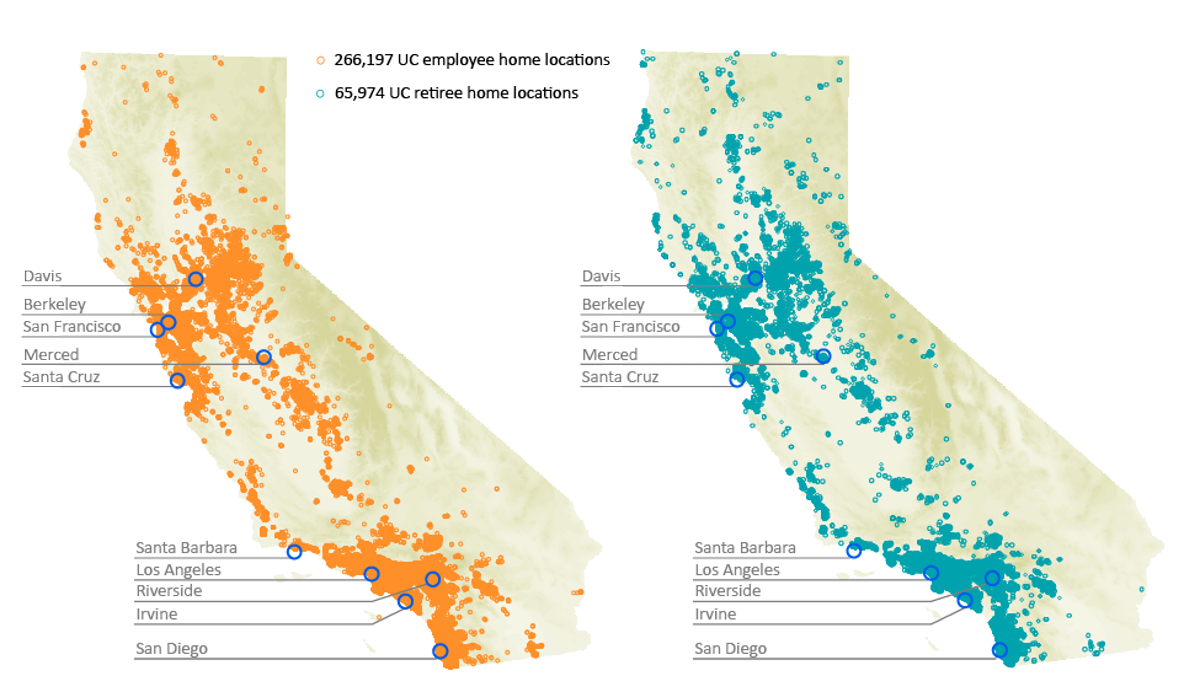Part of the UC mission
Along with teaching and research, UC contributes to the well-being of the state’s population and economic growth through its public service efforts. UC’s impact goes well beyond its on-campus activities. UC has a significant presence in nearly every community throughout California.
UC Agriculture and Natural Resources (UC ANR) and the UC Natural Reserve System (NRS) support sustainable agriculture, environmental stewardship, healthy families, and education. (As a department of the Research and Innovation division, NRS activities are discussed in chapter 9.) Every UC campus and UCOP’s Division of Graduate, Undergraduate and Equity Affairs (GUEA) administer hundreds of thousands of community-based programs across a range of foci, from community and social services to teacher professional development and K–12 student services.
UC Agriculture and Natural Resources
UC Agriculture and Natural Resources (UC ANR) implements the land-grant mission for the University, which emphasizes the development and dissemination of practical information to address critical agricultural, environmental, and societal issues. The land-grant system represents a three-way partnership with federal, state and county governments. More information about UC’s land-grant arm.
UC ANR statewide network and impact
UC ANR operates a statewide network of researchers and educators which includes the multi-campus Agricultural Experiment Station and statewide Cooperative Extension. There are approximately 520 Agricultural Experiment Station researchers located on five campuses: UC Berkeley, UC Davis, UC Merced, UC Riverside, and UC Santa Cruz. There are around 115 Cooperative Extension Specialists on nine UC campuses, Research and Extension Centers (RECs), and county offices, and 180 Cooperative Extension Advisors conducting research, outreach, and education in all 58 California counties. Nine statewide RECs provide education for the public and places for researchers to conduct field experiments. UC ANR is often the face of the University to Californians with no other connection to UC.
UC ANR people and programs connect and deliver resources from the entire UC system, forming integrated teams to work on complex issues and develop innovative, multidisciplinary, science-based solutions to improve the lives of all Californians. UC ANR benefits communities across the state, contributing to President Drake’s priorities for UC. Several impact highlights follow. For more information on its breadth of impact see the 2023 UC ANR Annual Report.
Leading on climate change
- The Climate Smart Agriculture Program, a partnership with the California Department of Food and Agriculture, assists farmers and ranchers with grant application assistance, project implementation support, and education on climate-smart agriculture adoption through workshops and field days. The program focuses on working with underserved producers and offers information in English, Spanish, Mandarin, Hmong, Cantonese, Punjabi, and lu Mien. Since 2019 almost $39M has been awarded to over 1,785 farmers and ranchers in 33 counties to implement science-based climate-smart practices that support climate change mitigation by reducing greenhouse gas emissions and sequestering carbon and promote climate change adaptation by increasing on-farm resilience.
- The statewide Environmental Stewards Program conducts activities and training to engage the public in the study and stewardship of California’s natural communities. The program increases knowledge, skills, and self-efficacy related to the state’s natural history and environmental issues; increases public participation and civic engagement in environmental education; and enhances citizen science, climate adaptation, and planning toward environmental and climate justice. The program co-develops, delivers, and evaluates instructor trainings to partner organizations, who then extend the Environmental Stewards and Climate Stewards certification courses. In the first three years of the Climate Stewards program, 623 participants potentially reduced carbon emissions by 1,782 tons of CO2.
Expanding opportunity and excellence
- The statewide 4-H Youth Development Program engages youth ages 5–19 to reach their fullest potential while advancing the field of youth development. In 2023, there were approximately 57,700 California youth enrolled. In a recent study on the long-term impacts of participation, 84 percent of the 695 UC 4-H alumni respondents reported the program helped them succeed in their careers later in life. Findings also show the program helped foster a sense of responsibility that lasted into adulthood. UC 4-H alumni reported volunteering 130 hours annually, compared to the general population’s 57 hours annually, and 65 percent of 4-H alumni always vote, compared to 57 percent of the general population.
Strengthening an inclusive, respectful and safe community
- UC ANR teaches its academics, staff, and volunteers cultural competency skills to better engage diverse audiences in research and education. For example, at the 2023 UC ANR Statewide Conference a panel shared best practices for engaging Tribes and Tribal communities with over 100 participants. After attending the session, 44 participants responded to the evaluation survey, and 73% said they had greater confidence in reaching out to Tribes and 68% said they learned something.
- UC ANR extends research to decision-makers to help make the agricultural sector more inclusive. Two UC ANR academics served on the Sustainable Pest Management workgroup for the California Department of Pesticide Regulation (DPR) and represented the needs of underserved farmers and organic growers, diversified and small-scale. As a result of their participation in the workgroup, DPR included the interests of farmers who have historically received less support from state and federal agricultural agencies in a new guiding document, “Accelerating Sustainable Pest Management: A Roadmap for California.” Their inclusion in the roadmap increases the resiliency and success of these farmers in the future.
Promoting health in California’s vulnerable communities
- The California Expanded Food and Nutrition Program (EFNEP) delivers research-based nutrition education to limited-resource families with young children to improve healthy lifestyle choices. In 2023, EFNEP graduates statewide averaged a $63.95 savings in their monthly grocery budget, which is $767 in savings a year per family. After completing EFNEP classes, the number of participants reporting they were unable to afford balanced meals fell from 89% to 37%.
- There is an ongoing need to increase participation in the CalFresh (SNAP) benefits program and connect families to additional resources. UC ANR academics provide support to improve usage of CalFresh and Market Match programs at farmers markets. For example, redemption at farmers markets increased in San Luis Obispo by 112% since 2021 and in Marin County by 99% between 2020 and 2022, which improves food security by increasing access to healthy local food.
Graduate, Undergraduate and Equity Affairs programs
Graduate, Undergraduate and Equity Affairs (GUEA) provides leadership and support for efforts that advance UC equity and inclusion, that promote access to and successful completion of baccalaureate and graduate degrees, and that help to provide an exemplary student academic experience. GUEA’s Outreach and Educational Partnerships supports and helps UC sustain partnerships with K–20 public education segments, community-based organizations, and the business sector. These collaborations advance college preparation, access, and degree-completion for students from underserved backgrounds.
Educational partnerships
The University of California’s Student Academic Preparation and Educational Partnerships (SAPEP) programs help prepare California students for higher education (10.2.1). SAPEP programs served nearly 130,816 K–12 students at 1,511 public schools, and 16,621 community college students at 109 community colleges in 2020–21, the most recent year available.
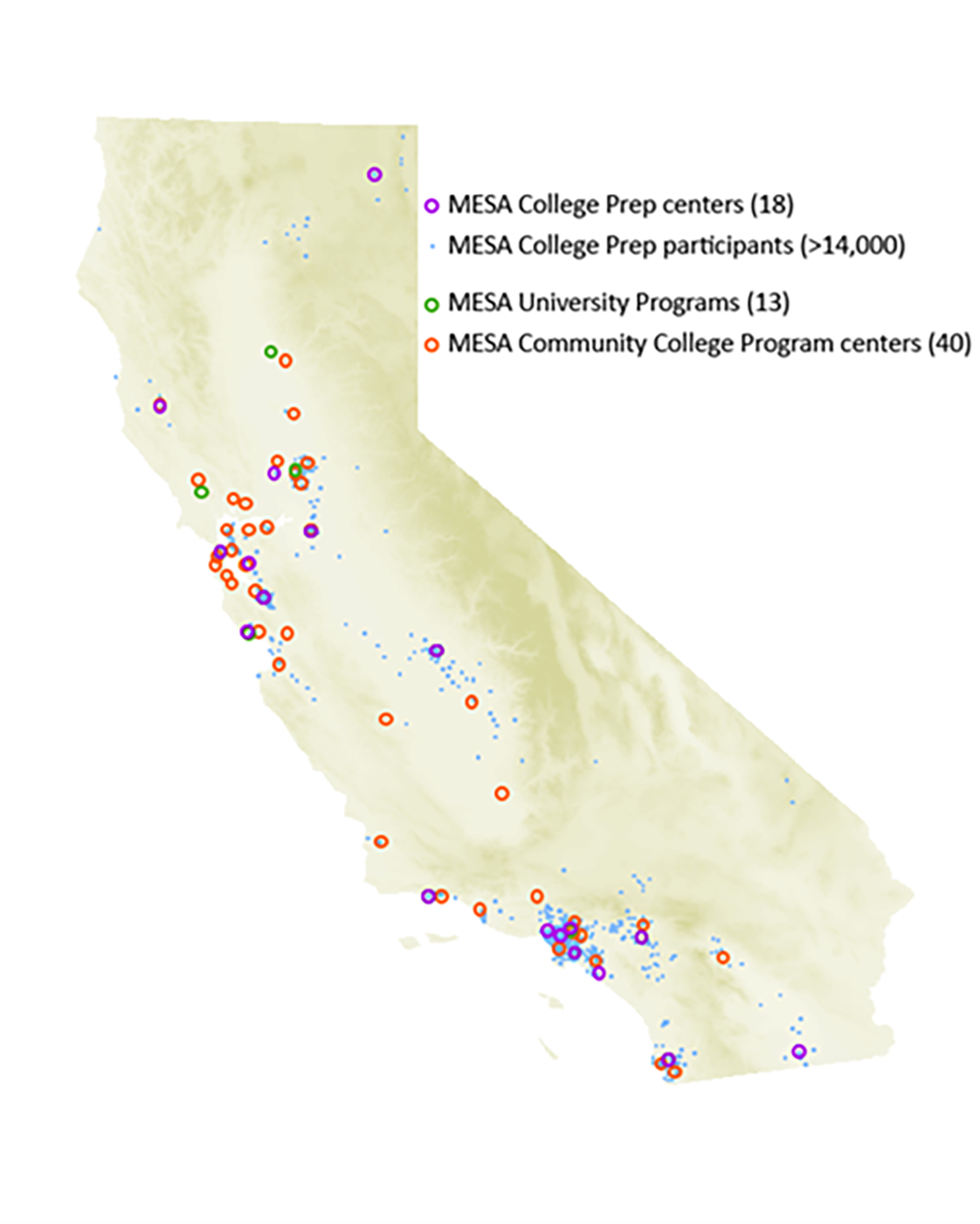
The goal is to promote achievement by supporting academic preparation and college readiness. Programs include the Early Academic Outreach Program (EAOP), which focuses on “a–g” course completion (a prerequisite for admission to UC and CSU); K–20 Regional Intersegmental Alliances (aka P–20), creating ties between campuses, schools, local communities, and business organizations; The Puente Project, focusing on college-preparatory English skill development; Transfer Prep, focusing on community college transfer support; and Mathematics, Engineering, Science Achievement (MESA), focusing on STEM (science, technology, engineering, and mathematics) skills development. he Mathematics, Engineering, Science Achievement (MESA) program integrates UC’s core missions of teaching and public service by focusing on the academic preparation of students at K–12 schools, community colleges, and four-year universities. Through its three components — the MESA College Prep Program (formerly known as MESA Schools Program or MSP), the MESA Community College Program (MCCP), and the MESA University Program (formerly known as MESA Engineering Program or MEP) — MESA serves more than 18,240 California students annually. (During the Covid pandemic, MESA saw a drop of around 6,000 students, primarily in the College Prep program, where middle school and high school students were most affected. Numbers began steadily rebounding as students returned to school, but have not yet reached pre-pandemic levels).
MESA College Prep centers are housed in 18 locations and serve more than 9,456 students at about 371 K–12 schools. Centers offer classes that reinforce math and science content standards. MESA activities include workshops aimed at strengthening study skills, monitoring progress, and encouraging students to pursue degrees in STEM.
The MESA Community College Program (MCCP) manages 85 centers at community colleges, serving 3,481 students annually. These centers provide academic excellence workshops, orientation courses, academic advising, and counseling activities to help community college students transfer to a four-year university in a timely manner.
The MESA University Program operates 19 centers located in public (UC and CSU) and private universities across the state. Serving 5,303 students annually, these centers assist college students in attaining four-year degrees in engineering and computer science by providing tutoring and academic skills workshops. In partnership with local industry leaders, MESA University Program centers also provide career and professional development opportunities for students.
UC also plays an important role in preparing California’s teacher workforce. UC’s Teacher Education Programs prepare teacher candidates to engage students in rigorous, relevant, and inquiry-based educational experiences. Located at eight UC campuses, Teacher Education Programs recruit, prepare, and support educators who are committed to academic excellence, equity, and integrity, and to cultivating the highest levels of achievement and opportunity for all students.
UC also provides ongoing support to educators already in the workforce through professional development programs. For example, the California Subject Matter Project (CSMP) is a network of nine discipline-based statewide projects, providing more than 700 professional development events for educators at more than 2,500 schools each year. CSMP professional learning opportunities are aligned with state-adopted standards and are collaboratively designed by K–12 and university educators to enhance learning for all students (10.2.1).
Social and economic impact
Including the programs of ANR and UC’s educational partnerships mentioned above, the University of California administers community-based programs at more than 7,000 sites across the state. The data on these sites is still being submitted into a new database and the number is expected to exceed 10,000. UC in California; Impact beyond campus borders, displays these programs on an interactive website. Because the well-being of every California citizen and community is important, all campuses sponsor and manage programs far from their campus locations (10.3.1).
Critical to the success of the University is a shared understanding with the California Legislature and California public of the enormous benefit UC provides to the state; its social and economic impact can be demonstrated with the UC in California maps (10.3.2).
More than 1.2 million UC alumni are known to live and work in California (10.3.3). They are leaders, volunteers, and contributors to the vitality of the state’s communities, businesses, and culture. UC’s operations also add significantly to the state’s economy. With more than 270,000 employees, UC is California’s third-largest employer (10.3.4). True to its land-grant mission, the UC system touches many aspects of life in California. The UC public service mission has evolved in tandem with the changing needs of our state and local communities, and has developed programs and partnerships that improve the lives of all Californians.
![]()


